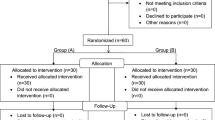Abstract
To compare the success and complications of ultra-mini percutaneous nephrolithotomy (UPNL) and standard percutaneous nephrolithotomy (SPNL) techniques. We prospectively analyzed 50 patients who underwent SPNL, and 47 patients who underwent UPNL. The patients with a stone size equal to or smaller than 25 mm and we used flipping a coin as the randomization technique. The mean stone size was 20.9 ± 3.6 mm in SPNL, and 20.3 ± 3.0 mm in ultra-mini PNL groups. Stone free rates were 88 % (44/50 patients) and 89.3 % (42/47 patients) in SPNL and UPNL groups, respectively, without any significant difference in between (p = 0.33). No major complications were seen in the UPNL group. PNL has been modified into micro PNL and UPNL parallel to the technological advances to decrease the complications of PNL. When performed as we do UPNL may be an alternative method to SPNL without any additional smaller-calibred nephroscope and with a similar high success rate.
Similar content being viewed by others
References
Turk C (2015) EAU guidelines on urolithiasis. http://uroweb.org/wp-content/uploads/EAU-Guidelines-Urolithiasis-2015-v2.pdf. Accessed 10 Feb 2016
de la Rosette JJMCH, Opondo D, Daels FPJ et al (2012) Categorisation of complications and validation of the Clavien score for percutaneous nephrolithotomy. Eur Urol 62:246–255
Cicekbilek I, Resorlu B, Oguz U, Kara C, Unsal A (2015) Effect of percutaneous nephrolithotomy on renal functions in children: assessment by quantitative SPECT of (99m)Tc-DMSA uptake by the kidneys. Ren Fail 37:1118–1121
Desai J, Solanki R (2013) Ultra-mini PCNL. European urology supplements. In: 28th annual EAU congress, 15–19 March, Milan, Italy
Desai MR, Sharma R, Mishra S, Sabnis RB, Stief C, Bader M (2011) Single-step percutaneous nephrolithotomy (microperc): the initial clinical report. J Urol 186:140–145
Tepeler A, Sarica K (2013) Standard, mini, ultra-mini, and micro percutaneous nephrolithotomy: what is next? A novel labeling system for percutaneous nephrolithotomy according to the size of the access sheath used during procedure. Urolithiasis 41:367–368
Kukreja R, Desai M, Patel S, Bapat S (2004) Factors affecting blood loss during percutaneous nephrolithotomy: prospective study. J Endourol 18:715–722
Helal M, Black T, Lockhart J, Figueroa TE (1997) The Hickman peel-away sheath: alternative for pediatric percutaneous nephrolithotomy. J Endourol 11:171–172
Dore B (2006) Complications of percutaneous nephrolithotomy: risk factors and management. Ann Urol (Paris) 40:149–160
De S, Autorino R, Kim FJ (2015) Percutaneous nephrolithotomy versus retrograde intrarenal surgery: a systematic review and meta-analysis. Eur Urol 67:125–137
Landman J, Lee DI, Lee C, Monga M (2003) Evaluation of overall costs of concurrently available small flexible ureteroscopes. Urology 62:218–222
Karatag T, Tepeler A, Silay MS, Bodakci MN, Buldu I, Daggulli MA (2015) Comparison of 2 percutaneous nephrolithotomy techniques for the treatment of pediatric kidney stones of sizes 10–20 mm: microperc vs miniperc. Urology 85:1015–1018
Michel MS, Trojan L, Rassweiler JJ (2007) Complications in percutaneous nephrolithotomy. Eur Urol 51:899–906
Resorlu B, Unsal A, Ziypak T, Diri A, Atis G, Guven S (2013) Comparison of retrograde intrarenal surgery, shockwave lithotripsy, and percutaneous nephrolithotomy for treatment of medium-sized radiolucent renal stones. World J Urol 31:1581–1586
Tefekli A, Ali Karadag M, Tepeler K, Sari E, Berberoglu Y, Baykal M (2008) Classification of percutaneous nephrolithotomy complications using the modified clavien grading system: looking for a standard. Eur Urol 53:184–190
Choi SW, Kim KS, Kim JH, Park YH, Bae WJ, Hong SH (2014) Totally tubeless versus standard percutaneous nephrolithotomy for renal stones: analysis of clinical outcomes and cost. J Endourol 28:1487–1494
Rifaioglu MM, Onem K, Buldu I, Karatag T, Istanbulluoglu MO (2014) Tubeless percutaneous nephrolithotomy: yes but when? A multicentre retrospective cohort study. Urolithiasis 42:255–262
Bilen CY, Gunay M, Ozden E, Inci K, Sarikaya S, Tekgul S (2010) Tubeless mini percutaneous nephrolithotomy in infants and preschool children: a preliminary report. J Urol 184:2498–2502
Jackman SV, Docimo SG, Cadeddu JA, Bishoff JT, Kavoussi LR, Jarrett TW (1998) The “mini-perc” technique: a less invasive alternative to percutaneous nephrolithotomy. World J Urol 16:371–374
Lahme S, Bichler KH, Strohmaier WL, Götz T (2001) Minimally invasive PCNL in patients with renal pelvic and calyceal stones. Eur Urol 40:619–624
Tepeler A, Armagan A, Sancaktutar AA, Silay MS, Penbegul N, Akman T et al (2013) The role of microperc in the treatment of symptomatic lower pole renal calculi. J Endourol 27:13–18
Desai MR, Sharma R, Mishra S, Sabnis RB, Stief C, Bader M (2012) ‘Microperc’ micro percutaneous nephrolithotomy: evidence to practice. Curr Opin Urol 22:134–138
Tepeler A, Akman T, Silay MS, Akcay M, Ersoz C, Kalkan S et al (2014) Comparison of intrarenal pelvic pressure during micro-percutaneous nephrolithotomy and conventional percutaneous nephrolithotomy. Urolithiasis. 42:275–279
Karatag T, Buldu I, Inan R, Istanbulluoglu MO (2015) Is micropercutaneous nephrolithotomy technique really efficacicous for the treatment of moderate size renal calculi? Yes. Urol Int 95:9–14
Kukreja RA, Desai MR, Sabnis RB, Patel SH (2002) Fluid absorption during percutaneous nephrolithotomy: does it matter? J Endourol 16:221–224
Stenberg A, Bohman SO, Morsing P, Müller-Suur C, Olsen L, Persson AE (1998) Back-leak of pelvic urine to the bloodstream. Acta Physiol Scand 134:223–234
Shah AK, Xu K, Liu H, Huang H, Lin T, Bi L et al (2015) Implementation of ultramini percutaneous nephrolithotomy for treatment of 2–3 cm kidney stones: a preliminary report. J Endourol 29:1231–1236
Ghani KR, Andonian S, Bultitude M, Desai M, Giusti G, Okhunov Z et al (2016) Percutaneous nephrolithotomy: update, trends, and future directions. Eur Urol. doi:10.1016/j.eururo.2016.01.047. (Epub ahead of print)
Author information
Authors and Affiliations
Corresponding author
Ethics declarations
Conflict of interest
All the authors declare that there is no conflict of interest.
Ethical approval
This article does not contain any studies with animals performed by any of the authors.
Informed consent
Informed consent was obtained from all of the participants that were included in the study.
Rights and permissions
About this article
Cite this article
Karakan, T., Kilinc, M.F., Doluoglu, O.G. et al. The modified ultra-mini percutaneous nephrolithotomy technique and comparison with standard nephrolithotomy: a randomized prospective study. Urolithiasis 45, 209–213 (2017). https://doi.org/10.1007/s00240-016-0890-9
Received:
Accepted:
Published:
Issue Date:
DOI: https://doi.org/10.1007/s00240-016-0890-9




